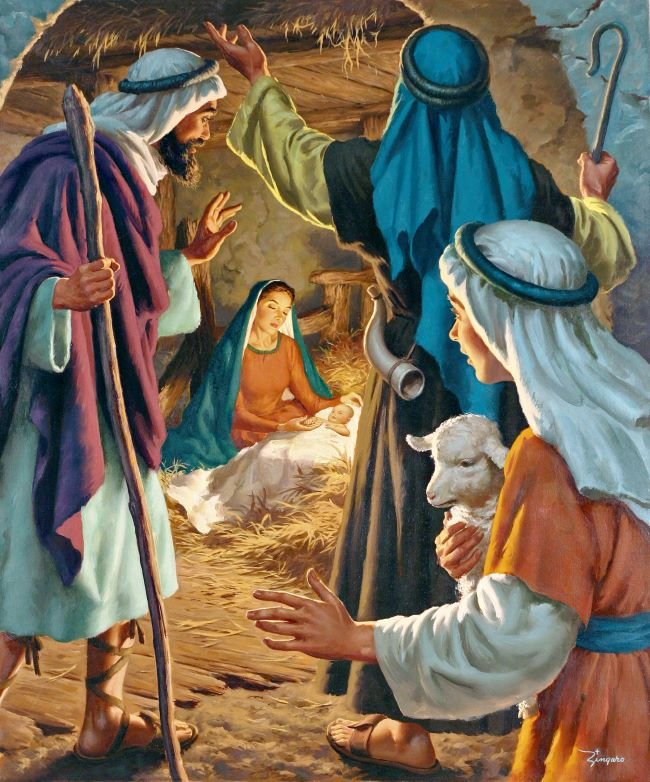Monday Meditation: ‘God Came Down,’ Part 3: Responding to the news
Years ago Standard Publishing where I worked offered a whole line of “Scratch ‘n’ Sniff” stickers. Little hands could peel off the pictures of strawberries or roses or pine trees and scratch the image to release a whiff of fragrance resembling the smell of the actual item.
We used to joke at coffee break about when we’d offer “Scratch ‘n’ Sniff Nativity” stickers.
But, of course, no one wants to think about what that stable probably smelled like. We’d rather focus on an idealized image like the portrayal in this week’s Bible art.
Hollywood set?
Our children’s Christmas programs don’t depict the blood and sweat of a real-life birth or imagine it spilling to a dirt floor littered with straw and dung. And neither does today’s picture.
Here Mary looks remarkably together just hours after experiencing her agony. It reminds me of all those movie scenes with a perfectly coiffed woman wearing lipstick and eyeshadow upon rising from bed first thing in the morning. We don’t want to see the rumpled side of real life.
The shepherds in our picture likewise look like they’re ready to step into a 1950s Hollywood set. No grime on garments unwashed after tending sheep in the open countryside. No caked mud on worn sandals covering dirty feet.
But we’re patient with this cleaned-up picture because it’s beautiful. And the event it illustrates was beautiful. Even more beautiful is the intent of God revealed in this week’s reading for us to believe and ponder.
Real lives
God intersected real life, not a pageant or sitcom, to make a difference in real lives.
• Lives of need like this teenage girl coping with a frightening miracle.
• Lives of isolation like these shepherds scratching out a living on the outskirts of their society.
They were afraid when confronted by the angel and his unbelievable message, just as Mary had been afraid many months earlier when the messenger came to turn her life upside down. But like Mary, they didn’t cower and they didn’t hesitate. As soon as the sky darkened and the remarkable praise ended, they said, “Let’s go!”
And they found in Bethlehem exactly—exactly!—what the angel had described. Their experience in the dark on a deserted hillside was no hallucination. God himself had orchestrated an announcement to convince them—and every observer since then—that he was making good on all those ancient prophecies of centuries earlier.
Deeper insight
We caregivers can read the familiar story again and consider our own needs.
We can think about Mary who treasured these experiences, “pondering them in her heart,” grateful for evidence that God really was with her. And we can look for evidence that he’s with us, too.
We can remember common shepherds overwhelmed with God’s glory even though they were not special at all. And we can believe that even though our loved one’s disease has moved them away from the mainstream, God hasn’t forgotten them.
Or us. We can consider the claims of this baby after he became a man. And we can believe that what happened in Bethlehem was only the beginning of God’s desire to forever revolutionize every person’s existence.
We can be patient with a picture that only hints at all God did and all God wants. And we can turn back to real life asking him what he wants for us.
Read: Luke 2:8-20
Pray: Thank you, God, for the angel messenger who told the first Christmas story, for the shepherd messengers who repeated it everywhere they went, and for contemporary messengers who help us think about it anew. Help us decide, Lord, what we can tell others about Christmas because you have brought Christmas to our lives, too.
Illustration copyright Classic Bible Art. All rights reserved. For more information about securing a library of this beautiful art for yourself, see here or here. Some art in this series is available for license at Goodsalt.com.
